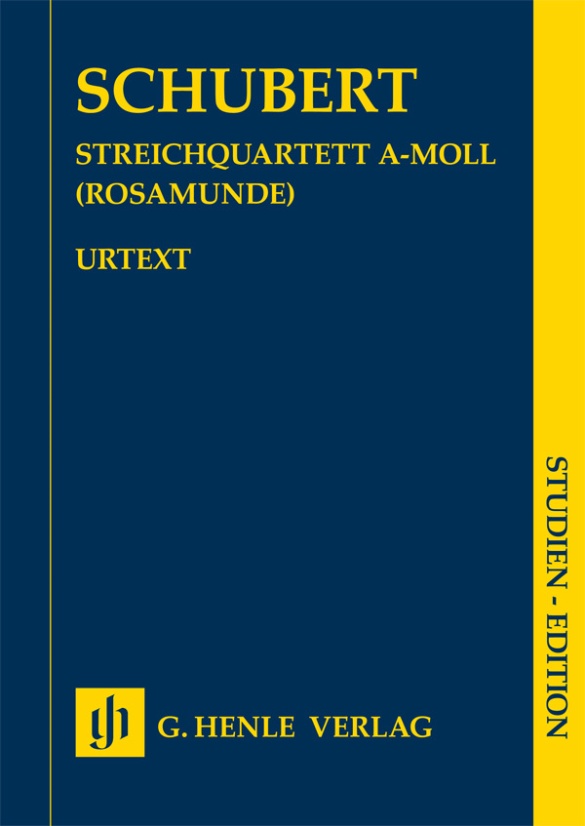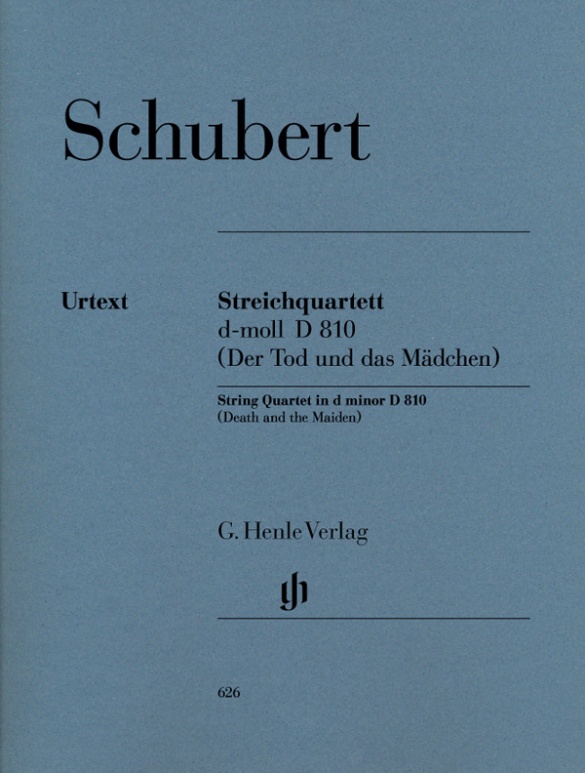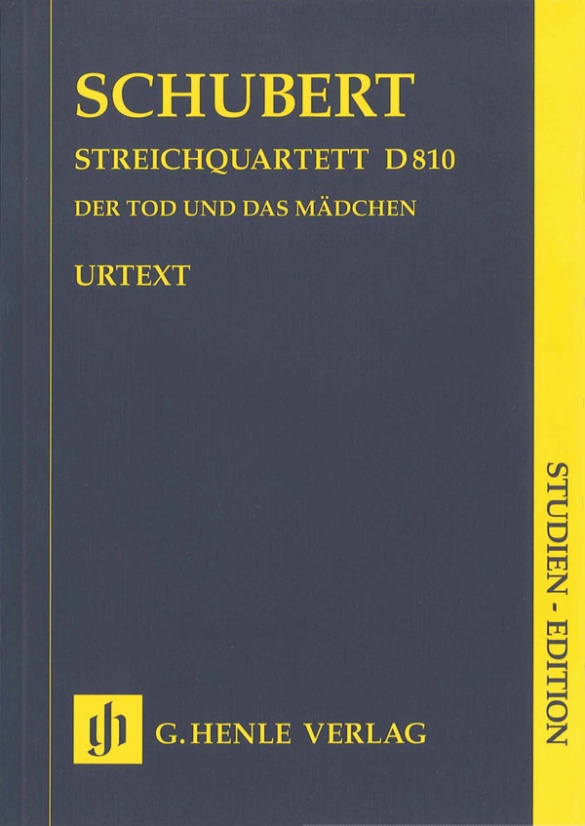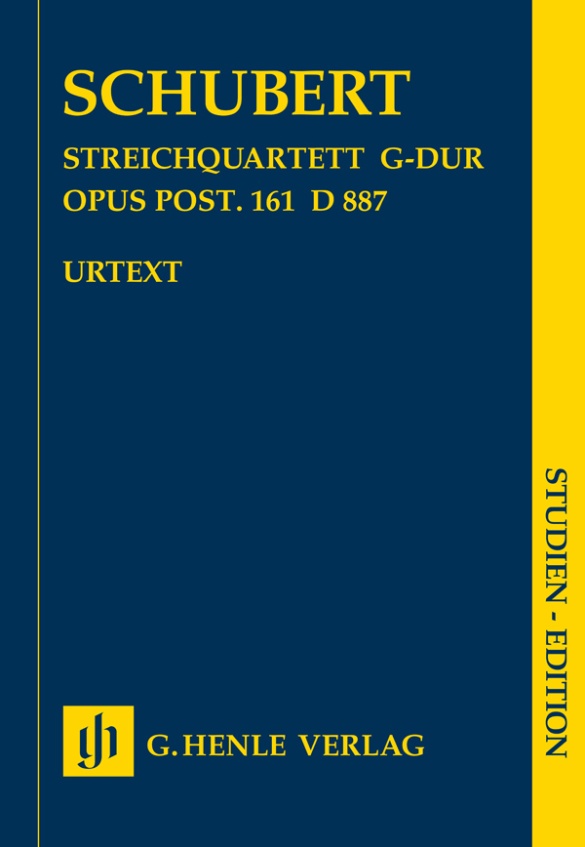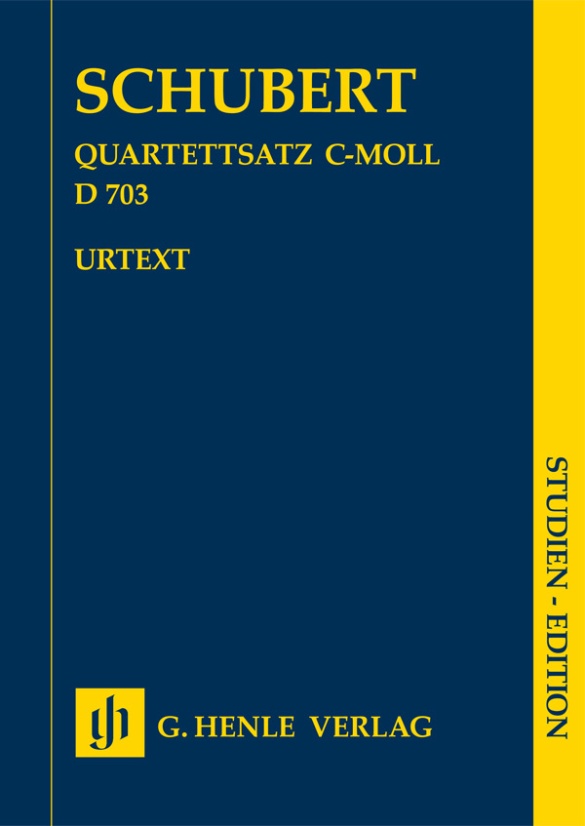

Franz Schubert
String Quartet movement c minor D 703
Schubert’s composition of a new string quartet begun in December 1820 was, alas, never to get beyond the first movement; the heavily reworked autograph breaks off at the outset of the second movement. But the fragmentary work that later came into the hands of Johannes Brahms from Schubert’s estate, delighted its new owner so much after its premiere in 1867 that Brahms had the first movement published three years later as Schubert’s “Posthumous Work” – thus paving the way into audiences’ hearts for this little gem. Schubert’s autograph manuscript features such numerous divergences in dynamics and articulation that editor Egon Voss suspects it to be one of Schubert’s experiments with variations. This is why in his Urtext edition he proceeds with extreme restraint in issuing additions and changes with respect to parallel passages ¬– thus making Schubert’s diversity of ideas comprehensible for performing musicians. For all who want a peek inside Schubert’s workshop, the few measures of the second movement are included as a bonus!
Content/Details
About the Composer
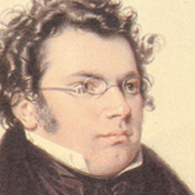
Franz Schubert
He is not only the inaugurator of the art song and its most important composer in the nineteenth century, but he also realized a compositional concept in his instrumental works that opposed Viennese Classicism. Underlying the “heavenly length” of his works is a configuration of time that does not function according to the principle of motivic development, but addresses the notion of lingering; modifications occur mostly not in continuous unfolding, but through sudden eruptions. His ornate songs contradict the ideal of simplicity in the Lied aesthetics of his time, and provide the basis for the art song of the nineteenth century, regarded as they were as exemplary by subsequent generations of composers; they are defined by complex harmonies, an integration of the idioms of instrumental music, semantic models, and a new relationship between text and music in which the poem as a whole is interpreted through the composition, rather than just through word painting. His immense oeuvre in spite of his brief life comprises 600 songs, including his two famous song cycles; seven complete and several unfinished symphonies (including the “Unfinished” in B minor); other orchestral works; numerous pieces of chamber music; fourteen complete and several unfinished piano sonatas as well as other piano pieces; dances for piano and four-hand works; six masses and other sacred compositions; numerous pieces for choir or vocal ensemble, especially for male voices. Although he also contributed to every genre of music theater and his friends predicted a career for him in opera, only two of his ten finished operas were performed during his lifetime, as was the incidental music to “Rosamunde.”
| 1797 | Born in Himmelpfortgrund near Vienna on January 31, the son of a teacher. First piano lessons from his brother Ignaz, violin lessons from his father at age eight. |
| from 1808 | Choirboy in the Imperial Chapel; attends the imperial and royal boys choir school (“Stadtkonvikt”), playing violin in its orchestra. Lessons from Antonio Salieri, who attempts to win over the boy enamored with Mozart, Haydn, and Beethoven to Italian opera. First surviving compositions. |
| 1811 | Composition of his first song, “Hagars Klage.” |
| 1813–14 | Attends the pedagogical secondary school, after which he teaches in his father’s school. |
| 1813/14 | Composition of the magical opera “Des Teufels Lustschloss” and the Symphony No. 1 in D major in classical form. |
| 1814 | Composition of the Mass in F Major, D 105. He writes songs, which he groups by their poets, e.g. Matthisson and Goethe, including “Gretchen am Spinnrade,” which marks the birth of the art song. |
| 1815 | Composition of the musical comedy “Claudine von Villa Bella” after Goethe and “Der vierjährige Posten.” Completion of the Symphony No. 2 in B-flat major and composition of the Symphony No. 3 in D major as well as the Masses in G major and No. 3 in D major; the song “Erlkönig,” among others. |
| 1816 | Composes 110 songs, the Symphonies No. 4 in C minor and No. 5 in B-flat major, and the Mass in C major. He leaves his parents’ home, suspends his position as teacher, and moves in with Schober. |
| 1817 | Sixty songs, including “Der Schiffer,” “Ganymed,” “An die Musik,” “Die Forelle,” “Gruppe aus dem Tartarus,” “Der Tod und das Mädchen.” Gradually his compositions are performed (his oeuvre already comprises around 500 works). Returns to his parental home. |
| 1818 | He teaches the daughters of Count Johann Karl Esterházy. Composition of four-hand piano pieces. |
| around 1819 | Composition of the Piano Quintet in A major (“Trout” Quintet). |
| 1820 | Premiere in Vienna of the melodrama “Die Zauberharfe” and the musical comedy “Die Zwillingsbrüder.” The song “Frühlingsglaube,” among others. |
| 1821 | First Schubertiade: a convivial musical- and literary evening meeting of Schubert’s circle of friends. Publication of the songs “Erlkönig” and “Gretchen am Spinnrade” as well as other Goethe songs and 36 dances. |
| 1821–22/54 | Composition/premiere of “Alfonso und Estrella,” one of the early through-composed German operas. |
| 1822 | Completion of the Mass in A-flat major; Symphony No. 7 in B minor (“Unfinished”); Wanderer Fantasy in C major for piano, which unites in one movement the four different characters of symphonic movements. |
| 1823 | Composition of the musical comedy “Die Verschworenen” (premiere in Frankfurt am Main in 1861), the heroic-Romantic opera “Fierrabras” (premiere in Karlsruhe in 1897), and the incidental music to “Rosamunde,” which is premiered in Vienna. Song cycle “Die schöne Müllerin,” songs “Auf dem Wasser zu singen,” “Lachen und Weinen,” among others; Piano Sonata in A minor, D 784. |
| 1824 | Once more teacher of the children of Count von Esterházy. String Quartet in D minor (“Death and the Maiden”). “Wandrers Nachtlied” (“Über allen Gipfeln ist Ruh”). The piano sonata takes on greater importance. |
| 1825 | Long holiday travels, including to Gmunden-Gastein, where he composes the Great Symphony in C major (No. 9 or No. 8), in which he considerably expands classical form (e.g. horn motto at the beginning, configuration of time). |
| 1827 | Song cycle “Winterreise” (contrasts dream sequences with reality); German Mass; four Impromptus for piano; Piano Trios in B-flat major, D 898, and E-flat major, D 929. |
| 1828 | Publication of the “Six Moments Musicaux” for piano. Composition of the last three piano sonatas in C minor, A major, and B-flat major (the latter with a tendency towards the esoteric), the sonata movement in A minor (“Lebensstürme”), the Mass in E-flat major. “Thirteen Songs after Poems by Rellstab and Heine” (posthumous “Schwanengesang,” “Swan Song”). In March, a concert dedicated to only his own music. Death in Vienna on November 19. |
About the Authors
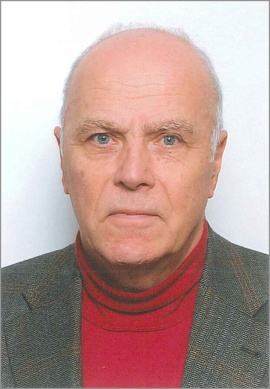
Egon Voss (Editor)
Dr. Egon Voss, born in 1938 in Magdeburg, did a secondary school teaching degree in Detmold (Staatsexamen in 1961) and studied German, philosophy and pedagogy in Kiel and Münster (Staatsexamen 1964). He subsequently studied musicology in Cologne, Kiel and Saarbrücken and completed his doctorate in 1968.
In 1969 Voss became a scholar at the Richard Wagner Complete Edition in Munich, since 1981 he has been its Head. From 1989 to 1990 he was the dramaturg at the Théȃtre la Monnaie/de Munt Brüssel, and from 1996 to 2002 a lecturer at the post-graduate programme “Textkritik” at the Ludwig-Maximilians-Universität in Munich. Voss is a member of the advisory board for the edition “Richard Wagner, Sämtliche Briefe” as well as the journals “wagnerspectrum” and “The Wagner Journal”. He has published several books and a great many essays on Wagner, Schumann, Bach and other composers and musicological topics.
Product Safety Informations (GPSR)

G. Henle Verlag
Here you can find the information about the manufacturer of the product.G. Henle Verlag e.K.
Forstenrieder Allee 122
81476 München
Germany
info@henle.de
www.henle.com
推荐
autogenerated_cross_selling
本书目其他版本


